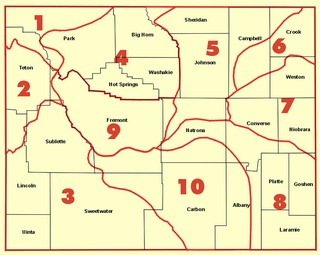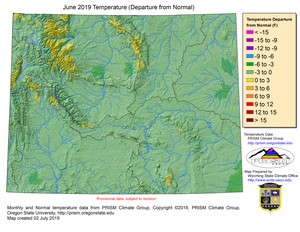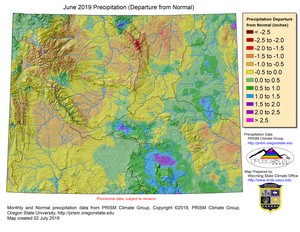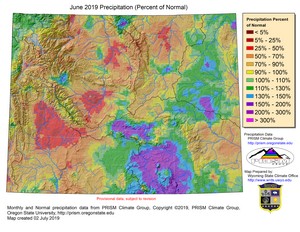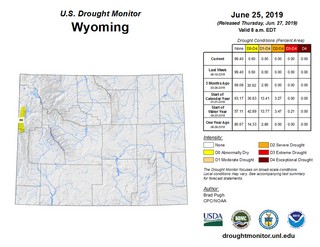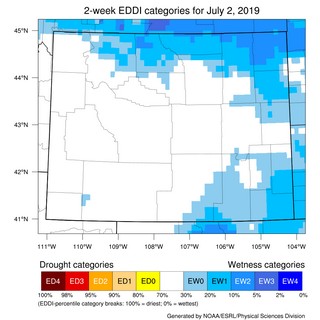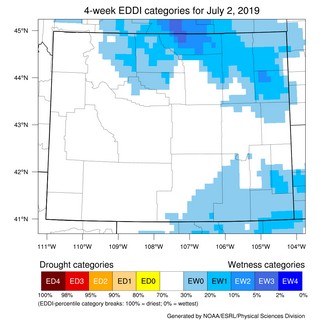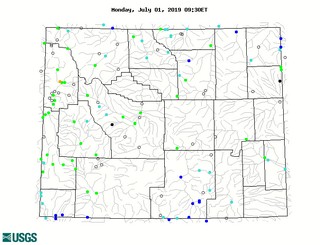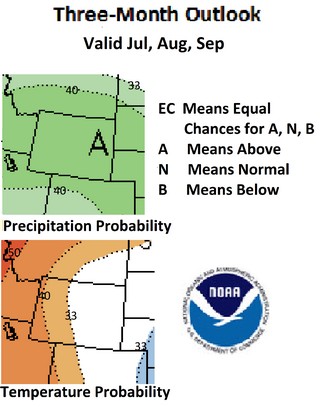 | |
 | |
| WRDS/SCO is currently working remotely so there may be a slight delay returning phone calls. Please email wrds@uwyo.edu if you are in need of information and we will respond as soon as possible |
|
| ||||||||||||
Drought Impacts and Outlook Summaries - 11 July 2019View this Summary as a PDF
Highlights for the State
Precipitation rankings were a bit more varied during June with CD 6 in the northeast having the driest ranking at 36 out of 125. At the other end of the spectrum was CD 10 which ranked as having its 31st wettest June since 1895. July (thru the 11th) has been wet across the northeastern half of the state while the southwest and southcentral portions have received below-normal precipitation. Temperatures have been cool with only a few stations in the south and northwest running up to 2 degrees F above normal. Generally, the northeastern two-thirds of the state has had a greater departure below normal than the southern and western thirds have.
Drought In the southwest, an area of D0 (Abnormally Dry) that initially covered half of Uinta county was also reduced and ultimately removed. Northwest Wyoming did not see as much of the moisture that other parts of the state experienced and, as a result, the only patch of drought in Wyoming is the D0 that is lingering in the Tetons. The southwest also missed out on precipitation and, as a result, is an area to watch. Evaporative Demand throughout much of the state is normal and precipitation for the coming weeks is expected to be below normal while temperatures will be above normal. The combination of these factors could result in a reemergence and spread of drought, especially in the Green River Basin.
Evaporative Demand The Evaporative Demand Drought Index (EDDI) at the end of June is showing normal to low-demand conditions across Wyoming. Looking at the conditions over the last two weeks, most of Wyoming is showing normal evaporative demand while the north and southeast are in low-demand conditions. The 4-week period ending 02 July shows much the same conditions. Additional products can be found at: http://www.wrds.uwyo.edu/sitemap.html Do you have drought impacts to report? We need your on-the-ground reports and you can input them here: http://droughtreporter.unl.edu/submitreport/
Water Resources Reservoir conditions may be viewed online in larger format at: http://www.wrds.uwyo.edu/surface_water/teacups.html Streamflows in Wyoming are at or above normal with the exception of a half dozen in the northwest and one in far northeast Weston County. The map below shows streamflow conditions in Wyoming as of July 01.
Weather and Climate Outlooks For temperature look for above-normal temperatures across the state for the next two weeks with the chances higher in the east. Toward the end of the month much of the state could be either above, below, or normal with the exception of better chances for above-normal temperatures in the far southwest and below-normal temperatures in the northeast. Through the rest of the summer Wyoming is expected to see above-normal precipitation. For temperature, the July through September time period has the western half of the state leaning toward above-normal temperatures with an uncertain signal for the eastern half. Starting with the August through October time period, the entire state has the odds favoring above-normal temperature going through the end of the year.
You can help us
Heard around the State Washakie Co., Jun 15: "Rivers and creeks remain high due to warmer temps and snowmelt. Fields, gardens and flowers are planted and growing." Park Co., Jun 16: "Good grassland this year, it's been cold. Plenty of spring water and last years planted alfalfa has thrived due to the wet spring." Johnson Co., Jun 19: "Customers report they've never seen it rain this late into the year. Business has been really slow because of the weather. vegetation growth is amazing." Sheridan Co., Jun 21: "Extremely wet spring this year-affecting growing season for both weekend gardeners such as me and also ranchers and farmers in the area."
Partners
Stay Tuned and In Touch The Wind River Indian Reservation and Surrounding Area Conditions may be found here: https://hprcc.unl.edu/windriver.php |
||||||||||||



